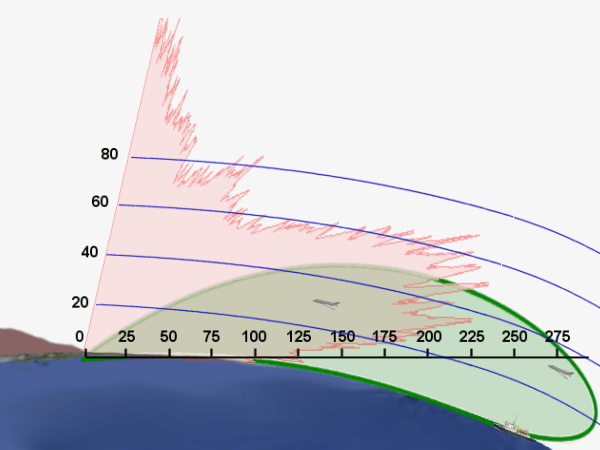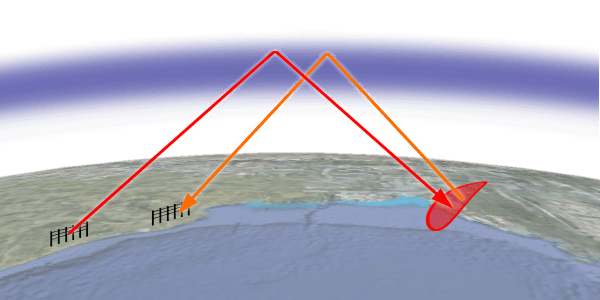Over-The-Horizon Radar (OTH)

Figure 1: Radar coverage on an Over-The-Horizon Surface Wave radar (green area) in comparison to an En-Route Radar (in red)

Figure 1: Radar coverage on an Over-The-Horizon Surface Wave radar (green area) in comparison to an En-Route Radar (in red)
Normally radar systems have a problem: the bend of the Earth surface. The maximum range of these radars is limited by the radio horizon – slightly far away than the optical horizon. OTH radars use very long wave lengths with special properties of propagation. Given the long wavelengths, an OTH antenna array is a sprawled business, stretched out over kilometers. Some OTH radars use FMCW to maximize signal energy, and such systems require separate transmit and receive antenna arrays.
Several OTH radar systems were deployed starting in the 1950s and 60s as part of early warning radar systems, but these have generally been replaced by airborne early warning systems instead. OTH radars have recently been making something of a comeback, as the need for accurate long-range tracking becomes less important with the ending of the Cold War, and less-expensive ground based radars are once again being looked at for roles such as maritime reconnaissance and drug enforcement.
Over–The–Horizon Surface Wave (OTH–SW)
OTH-SW radars use a very low transmission frequency from 2…3 MHz up to 20 MHz. These electromagnetic waves tend to bend or “diffract” around edges or curves, they are coupled to the conductive ocean surface forming a “ground wave”. They can bend over the horizon and will follow the curvature of the earth. The Figure 1 shows in red color an antenna pattern of an en-route radar using direct wave in Gigahertz region in comparison to an OTH–SW radar shown as the green one pattern.
Raytheon Canada and the Canadian military developed such radar, designated the HF-SWR-503. This is an oceanic surveillance system for monitoring such illegal activities as drug trafficking, smuggling, piracy, illicit fishing and illegal immigration. In addition, it may be used for tracking icebergs, environmental protection, resource protection, sovereignty monitoring and remote sensing of ocean surface currents and winds as well as assist in search and rescue operations.
It consisted of an array of monopoles 660 meters (2,165 feet) long, with the monopoles spaced at about 50 meters (164 feet), corresponding to half the wavelength of the radar's 3 MHz operating band. The array has a field of view of 120 degrees and can track targets to the limit of Canada's 370 kilometer (200 nautical miles) oceanic economic exclusion zone. It can obtain positions accurate to within hundreds of meters. Raytheon stated that a similar array could be used to track low-flying cruise missiles if it operated at a frequency of 15 to 20 MHz.
A German OTH-SW application with more civil use is the WERA radar. The WERA system is a shore based remote sensing system to monitor ocean surface currents, waves and wind direction. It uses the principle of FMCW with very slow sweep period of typically 0.3 sec. This oceanography radar can pick up back-scattered signals (Bragg effect) from ranges of up to 200 km.

interest
Figure 2: Principle of Over-The-Horizon Backscatter Radar
Over–The–Horizon Backscattering (OTH–B)
It is also possible to build radar that has “over the horizon” range, obtained by “bouncing” or “backscattering” radio waves off the ionosphere, the ionized layer at the top of the atmosphere. It uses slightly higher frequencies (up to 50 MHz). The scheme has many similarities to OTH-SW, requiring large antenna arrays.
Even at RF frequencies, OTH-B is dodgy to do. The exact properties of the ionosphere can vary, sometimes wildly, over the course of a day, and even when it's stable it's not like a radio “mirror”, crisply reflecting radio waves back down towards the ground, instead tending to smear out and scatter pulses. Of course, along with a range of thousands of kilometers comes extremely weak returns. OTH-B requires a good deal of sophisticated radar signal processing.
